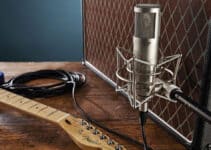From the March 2017 issue of Acoustic Guitar | BY PETE MADSEN
THE PROBLEM
You find that you can’t get a powerful sound playing bottleneck slide—your tone is thin.
THE SOLUTION
There are several things you can do to get a good slide sound: Set up your guitar with heavier strings, use an open tuning, try different kinds of slides, dampen the strings, and learn to properly intonate. Getting a good sound is often as much a function of proper setup as it is technique. Some guitarists like to raise the action on a cheap guitar and put on heavy-gauge strings—guitars with low action and light-gauge strings make it difficult to get a good tone because the extra weight of the slide can bang into the fretboard and produce unwanted sounds.
For bottleneck style, you want the strings to be a little above the fretboard, but not too much. I’ve seen guitar stores that sell guitars with damaged necks as “slide” guitars because it’s impossible to press down on the string and play in tune. Avoid these.
Setup & Tuning
If you’re used to playing light strings, try a medium (.013–.056) set. Some guitarists like to swap out the E and B strings with gauges as heavy as .015 and .017. Be careful if you do that, because it will put extra tension on the neck and top of your guitar. If you use heavier strings, you might counteract the extra tension by tuning down to open G (D G D G B D), for example. Conversely, with light strings you can tune up to open A (E A E A CG E)—the relationship of the strings to each other is the same in open G and open A tunings, so musical ideas can easily be transferred between the tunings.
As for string height, you can place a shim under the saddle at the bridge, which should raise your action just enough to achieve a good sound. You can also buy a nut extender that you slide under the strings and which covers the nut. However, this might raise the action so high that it is impossible to fret the guitar normally.
Materials & Size
Slides come in a wide range of shapes, sizes, and materials. The best slide for you is a personal choice, both in terms of sound and comfort. After years of playing slide guitar, I’ve come to the conclusion that there are different slides for different applications. On the acoustic guitar, go for a slide with some mass: thick glass and ceramic slides work nicely, as do thick brass and steel. The more mass, the more sound. If you play fingerstyle in open tuning, choose a slide that is long enough to cover all the strings, at least 2 ½ inches in length. On the other hand, if you play mostly single-string and double-stop licks, then consider a smaller slide.
If it’s not too cost prohibitive, buy a small collection of different slides to see what works best for you.
Slides are generally inexpensive, and there are plenty of good options in the $10–$20 range.
Read more tips on choosing the best slide.
Technique & Intonation
Now that your guitar is set up and you’ve got a slide, it’s time to play! The following exercises are all in open-G tuning. As your slide touches the string, keep in mind that you don’t need to apply much pressure: It’s more important to keep consistent pressure as you slide from note to note. The slide should only cover the strings that you are playing slide notes on. For example, if you’re making a melody on the high E string, only cover that single string with the slide.
A lot of slide playing occurs on the high E, and these tips will help you get a good sound. As you move from note to note, target the fretwire itself, rather than playing between the frets as you would when fretting conventionally. Finally, tilt the slide slightly away from your body and the fretboard, thus avoiding other strings and unwanted overtones.
String Damping
A critical aspect of slide playing is string dampening, which can be achieved with both hands. There are times when you want string noise and overtones and there are times when you don’t. These tips are for avoiding those sounds. First, as you drag the slide across the strings, use one or more of your fretting fingers to touch and drag along that string behind the slide. I tend to use my first finger, which results in a slight cupping of my hand. This cupping also tends to consolidate your hand, making it feel as if it’s one appendage rather than five independent digits.
Beginning Open-G Exercises
In Ex. 1 on (scroll down), practice moving the slide between notes of the G-minor pentatonic scale. Make sure to keep your slide low, just covering the first string. Timing is not important. Just try to get a good, even sound, using your slide and damping finger.
In Ex. 2 use the same pentatonic scale, but work the third string. This will require you to “dip” the slide in. It’s okay to cover the first and second strings as well, but listen carefully: if it’s not pleasing to you, then you might need to angle the slide in so that you are not touching the top two strings. In Ex. 3 and 4, play on multiple strings. Make sure your slide is not tilted, so that all the strings have an even sound.
Ex. 5 offers a chance to vary the length of the slide notes. The first few notes are quick, but then the slide lingers a bit over the second string as you slide between the 10th and 12th frets. As you develop your slide playing, consider the difference between long vs. short, decay vs. sustain, and when to cut the note off with either your left or right hand.
Ex. 6 is an exercise in playing long and short slide notes. Cover the same territory between the third and eighth frets, but initially play the slide quickly and then stop the sound almost immediately. (Use your picking-hand palm or your fretting-hand damping finger.) On the second attempt, lengthen the note, taking your time getting from the third fret to the eighth fret. Notice the contrast and get familiar with both techniques.
Ex. 7 is a 12-bar solo in the key of G. The first four bars are played over a G7 chord. Basically, this portion of the solo travels between G octaves: high G on the fifth fret of the first string, down to the open third string, G. When the progression travels to C and D, you can simply follow the chords to the fifth and seventh frets, respectively, working your slide lick above and below those frets. The last two bars of the solo are a turnaround that you can use in any G blues.
Be patient as you work to get a good sound with the slide. Listen to recordings by as many players as you can—Robert Johnson, Son House, Charlie Patton, Alvin Youngblood Hart, Kelly Joe Phelps, among others—and try to emulate the sounds they get.

Get stories like this in your inbox

This article originally appeared in the March 2017 issue of Acoustic Guitar magazine.



